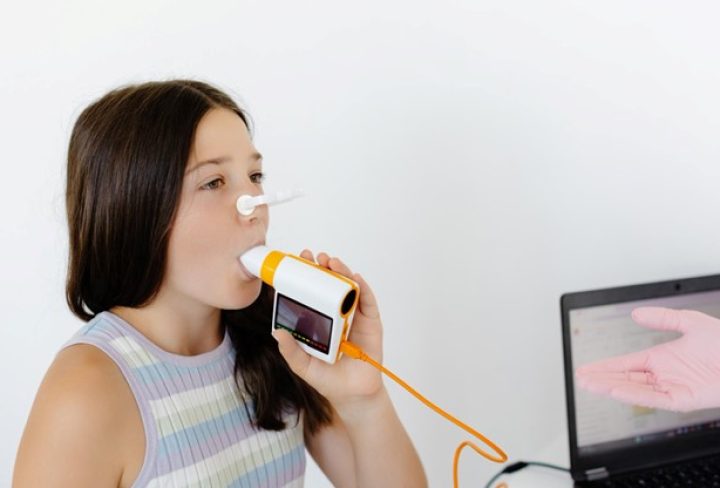Spirometry is a key player in understanding and managing your lung health. Knowing when and why it’s used can empower you to breathe easier.
Understanding Spirometry and Its Importance in Lung Health
Spirometry is like a window into your lungs, playing a vital role in measuring how well you can breathe. It serves as a spirometry test to assess lung capability. This tool helps detect problems in their early stages, which is crucial for treating and managing conditions like asthma or Chronic Obstructive Pulmonary Disease (COPD).
Definition and Purpose of Spirometry Tests
The spirometry test is simple but incredibly valuable. It involves blowing into a machine called a spirometer. This machine measures the amount and speed of air you can exhale. If you ever wondered what doctors are looking for, they’re checking how much air you can blow out in one big breath. This is called Forced Vital Capacity (FVC).
Another measure is the Forced Expiratory Volume in one second (FEV1). This tells the doctor how much air you can push out in a single second. Both these measures give clues about your lung health, telling them whether your lungs are working as they should.
Spirometry is especially important because it can catch problems early. Respiratory diseases can sneak up quietly. With a well-timed spirometry test, you might find out about a problem before even feeling any symptoms. This is important as it allows doctors to help plan the right treatment early. Starting early means better chances of keeping diseases in check.
How Spirometry Informs Treatment Plans
Doctors use spirometry results to make smart choices about how to treat respiratory issues. Let’s say you’ve already been diagnosed with asthma or COPD. The test can show how well your current treatment is working.
Through this check-up method, doctors can decide if any tweaks are needed in your medication. They can also see the progress over time, making adjustments as needed. It becomes a continual guide, helping ensure your treatment remains effective as conditions change.
Key Steps in the Spirometry Procedure and Test Preparation
When you’re scheduled for a spirometry test, knowing what to expect can make the process smoother and more comfortable.
Step-by-Step Guide to the Spirometry Procedure
- Getting Comfortable: First, you’ll sit comfortably with a clip on your nose. This ensures you only breathe out through your mouth.
- Preparing the Mouthpiece: You’ll place a special mouthpiece between your lips. This is where the breathing magic happens.
- Breathing Deeply: When instructed, you’ll take a deep breath in through your nose. Fill those lungs.
- Powerful Exhale: Blow out hard and fast through the mouthpiece. This part is crucial for measuring your FVC and FEV1.
- Repeating the Action: You’ll do this several times to ensure accurate results. Consistency in blowing technique is key for reliable data.
Knowing these steps can ease the anxiety about trying the spirometry procedure for the first time. It’s straightforward, mostly painless, and quick.
Preparing for a Spirometry Test
Getting ready for the test doesn’t take much work:
- Medication Adjustments: Your doctor might ask you to skip certain medications that affect breathing.
- Dietary Restrictions: Avoid heavy meals before the test. A full stomach can make it hard to give your best exhale.
- Wear Loose Clothing: Tight clothes can restrict breathing. Choose something comfy.
By following these simple tips, you’ll not only feel more at ease but get more accurate test results.
Utilizing Spirometry to Manage Asthma and COPD Effectively
For anyone dealing with asthma or COPD, spirometry is a significant asset. It’s more than just testing breath; it’s about improving life quality.
Advantages of Spirometry in Managing Chronic Conditions
You might wonder about the advantages of spirometry. It helps doctors see if your lungs are inflamed, or if medication is reducing inflammation effectively. In the case of asthma, spirometry for asthma diagnosis can confirm what’s causing difficulty in breathing.
With spirometry for COPD, doctors can gauge the severity of the condition. It helps in deciding the right treatment, flags when interventions need changes, and ensures your lungs are working at their best.
Thanks to regular checks with a spirometry test, you can manage these chronic conditions effectively. It provides a roadmap, giving your doctor a clear view and a solid plan for keeping symptoms at bay.
Safety Considerations and Potential Risks
Spirometry is generally safe for almost everyone. However, it’s worth noting that certain precautions are necessary. But don’t worry, the risks are quite low.
- Supervision is Key: Trained professionals oversee the test, ensuring accuracy and your safety.
- Risks are Minimal: Some might feel dizzy afterward or experience shortness of breath briefly.
Ultimately, when guided by an expert, it’s a low-risk procedure with high rewards in terms of respiratory health surveillance.
By incorporating spirometry procedure, testing, and frequent follow-ups in your healthcare routine, living well with asthma and COPD becomes much more achievable. This powerful test unlocks vital lung information, helping both you and your healthcare providers keep your lung health on track at every stage of your life.

